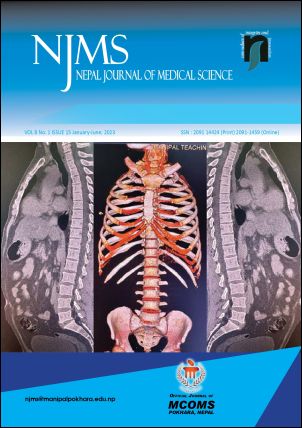Assessment of Anteroposterior Diameter, Interpedicular Distance and Cross-Sectional Area of the Lubar Spine in Patients Undergoing CT Scan in a Tertiary Care Center
DOI:
https://doi.org/10.3126/njms.v8i1.54309Keywords:
Lumbar Vertebrae, Spinal Canal, Spinal StenosisAbstract
Introduction: Lumbar spinal stenosis is a frequent cause of low back pain. Decreased lumbar spinal canal parameters are major risk factors for canal stenosis. This study was done to assess anteroposterior diameter, interpedicular distance and cross-sectional area of the lumbar spinal canal on a CT scan.
Methods: It was a cross-sectional descriptive study conducted at Nepal Medical College Teaching Hospital. Anteroposterior diameter, interpedicular distance and cross-sectional area of the lumbar spinal canal were measured.
Results: A total of 171 subjects were selected. The mean of anteroposterior diameter from L1-L5 was 16.46 mm, 16.05 mm, 15.04 mm, 15.08 mm and 15.23 mm respectively. The means of interpedicular distance from L1-L5 were 22.71 mm, 23.20 mm, 24.52 mm, 26.29 mm and 29.90 mm respectively. The means of cross sectional area from L1-L5 were 288.79 mm2, 2773.15 mm2, 266.84 mm2, 282.89 mm2 and 317.04 mm2 respectively. A statistically significant difference between sex and anteroposterior diameter was noted at L2 and the interpedicular distance was at L4 and L5 levels. The cross-sectional area has increased with increased age in all five vertebral levels but it showed statistically significant variation only at L1.
Conclusion: Anteroposterior diameter, interpedicular distance and cross-sectional area varies at each level on the lumbar vertebra and may vary according to age and sex.
Downloads
Downloads
Published
How to Cite
Issue
Section
License
Copyright (c) 2023 Nepal Journal of Medical Sciences

This work is licensed under a Creative Commons Attribution 4.0 International License.
Copyright © by Nepal Journal of Medical Sciences. The ideas and opinions expressed by authors of articles summarized, quoted, or published in full text in this Journal represents only opinions of authors and do not necessarily reflect the official policy of Nepal Journal of Medical Sciences or the institute with which the author(s) is (are) affiliated, unless so specified.




